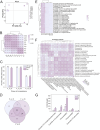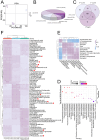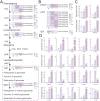Metabolome and transcriptome profiling reveals light-induced anthocyanin biosynthesis and anthocyanin-related key transcription factors in Yam (Dioscorea Alata L.)
- PMID: 40442608
- PMCID: PMC12123783
- DOI: 10.1186/s12870-025-06738-w
Metabolome and transcriptome profiling reveals light-induced anthocyanin biosynthesis and anthocyanin-related key transcription factors in Yam (Dioscorea Alata L.)
Abstract
Background: Yam is a globally significant crop with both culinary and medicinal value. Anthocyanin, an important secondary metabolite, plays a key role in determining the nutritional quality of yams. However, the research on the light-induced anthocyanins accumulation in yams remains limited. In this study, we revealed light-induced anthocyanin biosynthesis and identified transcription factors associated with anthocyanin-related pathways in yam. These findings enhance our understanding of the molecular mechanisms underlying light-mediated anthocyanin regulation in yams.
Results: Significant variations in color were observed in the stems, leaves, and tuber roots of the two yam varieties 'Xuwen' and 'Luhe'. Under light conditions, the total anthocyanin content in 'Xuwen' tuber roots was significantly higher than that under dark conditions. The targeted metabolomics analysis of anthocyanins identified that procyanidin and cyanidin glycosides, such as cyanidin-3-O-(sinapoyl)sophoroside, cyanidin-3-O-sophoroside, procyanidin B1, procyanidin B3, and quercetin-3-O-glucoside, were the primary anthocyanin components. These compounds were responsible for the observed differences in anthocyanin content between the two varieties and were significantly influenced by light conditions. The non-targeted metabolomics analysis further revealed that light also induce the biosynthesis of flavonoids. Transcriptome analysis showed significant differences in the expression levels of MYB, ERF, and WRKY transcription factors (TFs) between the two yam varieties, with these expressions being strongly influenced by light conditions. The association analysis of the anthocyanin metabolome, candidate TFs, and structural genes involved in anthocyanin biosynthesis revealed significant correlations. Specifically, MYB (Dioal.09G044700 and Dioal.12G068700) and WRKY (Dioal.20G040900 and Dioal.12G062900) showed strong correlations with procyanidins, anthocyanins, and the structural genes associated with anthocyanin biosynthesis. RT-qPCR confirmed that the expression patterns of these four TFs, strongly induced by light, were consistent with the expression of structural genes involved in anthocyanin biosynthesis.
Conclusions: The results of this study provide useful insights into the regulation of light on anthocyanin accumulation in yam, and will be helpful for yam breeding and cultivation practices.
Keywords: Anthocyanin; Light; Metabolome; Transcription factors; Transcriptom; Yam.
© 2025. The Author(s).
Conflict of interest statement
Declarations. Ethics approval and consent to participate: The experimental research on plants performed in this study complies with institutional, national and international guidelines. Consent for publication: Not applicable. Competing interests: The authors declare no competing interests.
Figures





Similar articles
-
Study on the dynamics of fruits color related genes and metabolites during the fruit development of Zanthoxylum bungeanum 'Hanyuan'.BMC Plant Biol. 2025 Jul 26;25(1):960. doi: 10.1186/s12870-025-06962-4. BMC Plant Biol. 2025. PMID: 40713503 Free PMC article.
-
Integrated omics and functional insights into BjMYB90-mediated regulation of BjGSTF12 for enhanced anthocyanin biosynthesis in mustard (Brassica juncea).Plant Cell Rep. 2025 Jul 2;44(7):166. doi: 10.1007/s00299-025-03542-6. Plant Cell Rep. 2025. PMID: 40601061
-
Unraveling the proteomic landscape of red-fleshed apples to identify regulators of anthocyanin accumulation.J Proteomics. 2025 Aug 15;319:105470. doi: 10.1016/j.jprot.2025.105470. Epub 2025 Jun 3. J Proteomics. 2025. PMID: 40472891
-
Systemic pharmacological treatments for chronic plaque psoriasis: a network meta-analysis.Cochrane Database Syst Rev. 2017 Dec 22;12(12):CD011535. doi: 10.1002/14651858.CD011535.pub2. Cochrane Database Syst Rev. 2017. Update in: Cochrane Database Syst Rev. 2020 Jan 9;1:CD011535. doi: 10.1002/14651858.CD011535.pub3. PMID: 29271481 Free PMC article. Updated.
-
Systemic pharmacological treatments for chronic plaque psoriasis: a network meta-analysis.Cochrane Database Syst Rev. 2021 Apr 19;4(4):CD011535. doi: 10.1002/14651858.CD011535.pub4. Cochrane Database Syst Rev. 2021. Update in: Cochrane Database Syst Rev. 2022 May 23;5:CD011535. doi: 10.1002/14651858.CD011535.pub5. PMID: 33871055 Free PMC article. Updated.
Cited by
-
Metabolomics reveals the differential regulatory mechanisms of quality and flavonoid biosynthetic pathways during the drying process of varieties licorice.Food Chem X. 2025 Jun 4;28:102631. doi: 10.1016/j.fochx.2025.102631. eCollection 2025 May. Food Chem X. 2025. PMID: 40528945 Free PMC article.
References
-
- Li M, Chen LX, Chen SR, Deng Y, Zhao J, Wang Y, Li SP. Non-starch polysaccharide from Chinese Yam activated RAW 264.7 macrophages through the Toll-like receptor 4 (TLR4)-NF-κB signaling pathway. J Funct Foods. 2017;37:491–500.
-
- Zhou Y, Farooqi AA, Xu B. Comprehensive review on signaling pathways of dietary saponins in cancer cells suppression. Crit Rev Food Sci Nutr. 2023;63(20):4325–50. - PubMed
-
- Eslami-Farsani M, Moslehi A, Hatami-Shahmir A. Allantoin improves histopathological evaluations in a rat model of gastritis. Physiol Int. 2018;105(4):325–34. - PubMed
-
- da Silva DM, Martins JLR, de Oliveira DR, Florentino IF, da Silva DPB, Dos Santos FCA, Costa EA. Effect of Allantoin on experimentally induced gastric ulcers: pathways of gastroprotection. Eur J Pharmacol. 2018;821:68–78. - PubMed
MeSH terms
Substances
LinkOut - more resources
Full Text Sources

